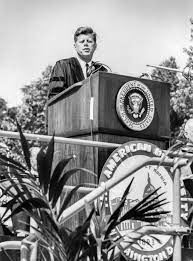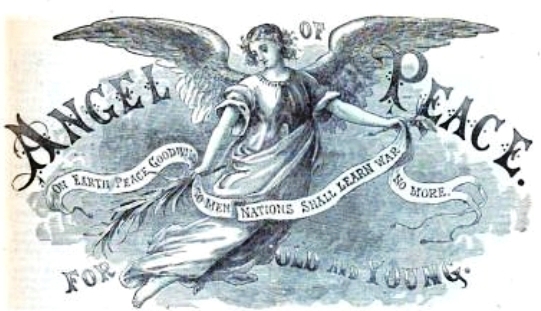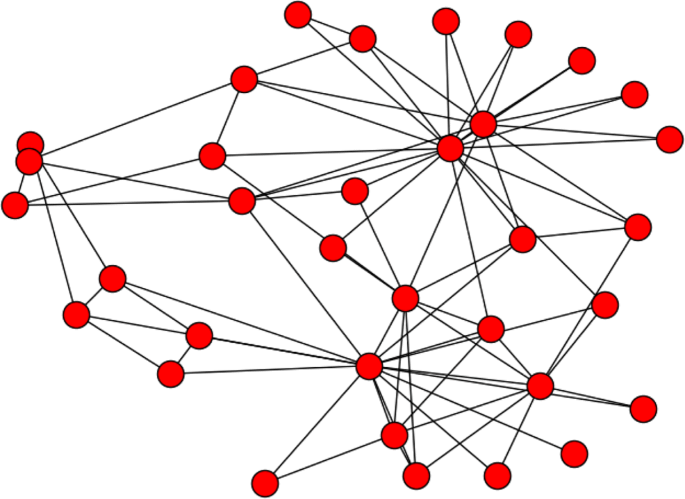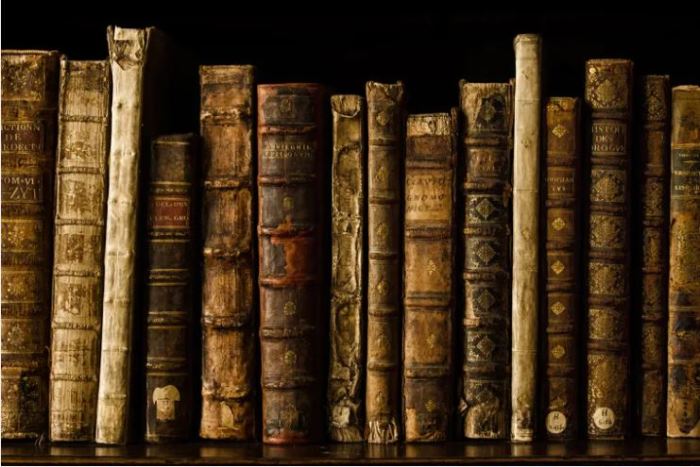Archive for the ‘Culture of peace’ Category
John F. Kennedy: We Must Avert Backing Russia into a Corner

THE most famous peace speech of President John F. Kennedy was a commencement address delivered at the American University in Washington, D.C. on June 10, 1963. Selections from the speech particularly relevant to the present world crises are shown below:
I have, therefore, chosen this time and this place to discuss a topic on which ignorance too often abounds and the truth is too rarely perceived — yet it is the most important topic on earth: world peace.
What kind of peace do I mean? What kind of peace do we seek? Not a Pax Americana enforced on the world by American weapons of war. Not the peace of the grave or the security of the slave. I am talking about genuine peace, the kind of peace that makes life on earth worth living, the kind that enables men and nations to grow and to hope and to build a better life for their children not merely peace for Americans but peace for all men and women — not merely peace in our time but peace for all time.
I speak of peace because of the new face of war. Total war makes no sense in an age when great powers can maintain large and relatively invulnerable nuclear forces and refuse to surrender without resort to those forces. It makes no sense in an age when a single nuclear weapon contains almost ten times the explosive force delivered by all the allied air forces in the Second World War. It makes no sense in an age when the deadly poisons produced by a nuclear exchange would be carried by wind and water and soil and seed to the far corners of the globe and to generations yet unborn. …
I speak of peace, therefore, as the necessary rational end of rational men. I realize that the pursuit of peace is not as dramatic as the pursuit of war — and frequently the words of the pursuer fall on deaf ears. But we have no more urgent task.
Some say that it is useless to speak of world peace or world law or world disarmament — and that it will be useless until the leaders of the Soviet Union adopt a more enlightened attitude. I hope they do. I believe we can help them do it. But I also believe that we must reexamine our own attitude — as individuals and as a Nation — for our attitude is as essential as theirs. And every graduate of this school, every thoughtful citizen who despairs of war and wishes to bring peace, should begin by looking inward — by examining his own attitude toward the possibilities of peace, toward the Soviet Union, toward the course of the cold war and toward freedom and peace here at home.
First: Let us examine our attitude toward peace itself. Too many of us think it is impossible. Too many think it unreal. But that is a dangerous, defeatist belief. It leads to the conclusion that war is inevitable — that mankind is doomed — that we are gripped by forces we cannot control.
We need not accept that view. Our problems are manmade — therefore, they can be solved by man. And man can be as big as he wants. No problem of human destiny is beyond human beings. Man’s reason and spirit have often solved the seemingly unsolvable — and we believe they can do it again.
I am not referring to the absolute, infinite concept of peace and good will of which some fantasies and fanatics dream. I do not deny the value of hopes and dreams but we merely invite discouragement and incredulity by making that our only and immediate goal.
Let us focus instead on a more practical, more attainable peace — based not on a sudden revolution in human nature but on a gradual evolution in human institutions — on a series of concrete actions and effective agreements which are in the interest of all concerned. There is no single, simple key to this peace — no grand or magic formula to be adopted by one or two powers. Genuine peace must be the product of many nations, the sum of many acts. It must be dynamic, not static, changing to meet the challenge of each new generation. For peace is a process — a way of solving problems.
With such a peace, there will still be quarrels and conflicting interests, as there are within families and nations. World peace, like community peace, does not require that each man love his neighbor — it requires only that they live together in mutual tolerance, submitting their disputes to a just and peaceful settlement. And history teaches us that enmities between nations, as between individuals, do not last forever. However fixed our likes and dislikes may seem, the tide of time and events will often bring surprising changes in the relations between nations and neighbors.
So let us persevere. Peace need not be impracticable, and war need not be inevitable. By defining our goal more clearly, by making it seem more manageable and less remote, we can help all peoples to see it, to draw hope from it, and to move irresistibly toward it.
Second: Let us reexamine our attitude toward the Soviet Union. …
No government or social system is so evil that its people must be considered as lacking in virtue. As Americans, we find communism profoundly repugnant as a negation of personal freedom and dignity. But we can still hail the Russian people for their many achievements — in science and space, in economic and industrial growth, in culture and in acts of courage.
Among the many traits the peoples of our two countries have in common, none is stronger than our mutual abhorrence of war. Almost unique among the major world powers, we have never been at war with each other. And no nation in the history of battle ever suffered more than the Soviet Union suffered in the course of the Second World War. At least 20 million lost their lives. Countless millions of homes and farms were burned or sacked. A third of the nation’s territory, including nearly two thirds of its industrial base, was turned into a wasteland — a loss equivalent to the devastation of this country east of Chicago.
Today, should total war ever break out again — no matter how — our two countries would become the primary targets. It is an ironic but accurate fact that the two strongest powers are the two in the most danger of devastation. All we have built, all we have worked for, would be destroyed in the first 24 hours. And even in the cold war, which brings burdens and dangers to so many nations, including this Nation’s closest allies — our two countries bear the heaviest burdens. For we are both devoting massive sums of money to weapons that could be better devoted to combating ignorance, poverty, and disease. We are both caught up in a vicious and dangerous cycle in which suspicion on one side breeds suspicion on the other, and new weapons beget counterweapons.
In short, both the United States and its allies, and the Soviet Union and its allies, have a mutually deep interest in a just and genuine peace and in halting the arms race. Agreements to this end are in the interests of the Soviet Union as well as ours — and even the most hostile nations can be relied upon to accept and keep those treaty obligations, and only those treaty obligations, which are in their own interest.
So, let us not be blind to our differences — but let us also direct attention to our common interests and to the means by which those differences can be resolved. And if we cannot end now our differences, at least we can help make the world safe for diversity. For, in the final analysis, our most basic common link is that we all inhabit this small planet. We all breathe the same air. We all cherish our children’s future. And we are all mortal.
Third: Let us reexamine our attitude toward the cold war, remembering that we are not engaged in a debate, seeking to pile up debating points. We are not here distributing blame or pointing the finger of judgment. We must deal with the world as it is, and not as it might have been had the history of the last 18 years been different.
We must, therefore, persevere in the search for peace in the hope that constructive changes within the Communist bloc might bring within reach solutions which now seem beyond us. We must conduct our affairs in such a way that it becomes in the Communists’ interest to agree on a genuine peace. Above all, while defending our own vital interests, nuclear powers must avert those confrontations which bring an adversary to a choice of either a humiliating retreat or a nuclear war. To adopt that kind of course in the nuclear age would be evidence only of the bankruptcy of our policy — or of a collective death-wish for the world.
Source: John F. Kennedy, Commencement Address at American University, Washington, D.C., June 10, 1963.
❧
What Ended the Golden Era of Peace Activism (1810−1850)?

THE period from 1810 to 1850 can be truly called a golden age of peace activism in the United States and England. In response to the Napoleonic Wars in Europe and the War of 1812 in America, many articles and pamphlets began to appear that denounced war. From about 1815, calls appeared to for creation of local peace societies. Eventually hundreds of such such societies emerged, the most influential being the Massachusetts Peace Society, the London Peace Society and the American Peace Society.
The movement as a whole had many notable achievements, including getting serious attention by government officials, shaping public opinion, organizing large protests, and eventually sponsoring three international congresses. However after 1850, in both the US and England, the movement began to lose force and never fully recovered. Today relatively few people — even antiwar activists — are familiar with this important part of history.
The historian Merle Curti, in a book devoted to this movement, mentions several possible reasons why the movement effectively ended. These are of more than mere historical interest: they should be considered in relation to the need to create a similarly effective organized movement today.
Briefly, the reasons for the movement’s waning include:
Reliance on charismatic leaders. The main figures in the peace movement — for example Noah Worcester and William Ladd in the US — were driven by immense passion and conviction and were tireless workers. Ladd, in particular, sacrificed not only his fortune but his health in his efforts. When this generation of leaders died, the movement lost force. Such is probably the pattern of many social movements.
Aging membership. Along with this was a gradual aging of the movement’s original members. It couldn’t replenish its ranks by interesting younger people to join.
Disillusionment. In England the bloody Crimean War first shook activists’ confidence, and then war piled upon war. Some became disillusioned; others succumbed to the growing war spirit.
Conflict with other ideals. Curti suggests that nationalism and liberalism became stronger ideals than peace. These movements not only drew away potential antiwar activists, but (as in the case of nationalist revolutions) sometimes made war seem justified. This remains a consideration today, as many people whom one might expect to support the cause of peace consider things like “democracy” and “social justice” legitimate reasons for aggression.
American Civil War. The Civil War effectively ended the peace movement in the US. For many, slavery was considered an evil sufficiently great to justify war.
Indifference of churches. Despite the fact that the founders of the movement were Christian and, at least initially, based their position on Christian teachings, they were never able to interest Christian churches at large. Unfortunately, the same remains true today.
Pendulum effect. Partly this occurred as an inevitable return swing of the pendulum. Any new social or intellectual movement meets with resistance. The struggle for peace cannot be accomplished quickly. One can only hope that over time gains will be greater than losses.
Internal friction. From the outset the movement was divided on the issue of defensive wars. Strict pacifists insisted that all war was wrong. Others contended that war in self-defense was legitimate. Pacifists countered that any war could be justified if one grants the principle of defensive war. There never was any solution to this split and it weakened the movement as a whole.
While the movement didn’t last, Curti also notes two important accomplishments. First, it produced solid arguments against war:
Perhaps the most striking contribution of early organized pacifism was the development of a body of brilliant arguments against war. By 1860 practically every argument against war now familiar had been suggested, and almost every current plan for securing peace had been at least anticipated. While the arguments against war in the earlier years were chiefly religious, moral, and philanthropic, they tended to become less and less an expression of the general spirit of liberalism and romanticism. They tended to become increasingly realistic and to make greater use of economic and political considerations. This was in part due to the working alliance of the free traders and peace men in England and to the influence of French socialist thought on the opponents of war. Increasing attention was given, for example, to the wastefulness of war and to the burdens it inflicted on the working classes. Much emphasis was put on the desirability of developing closer economic ties, bankers’ agreements for the refusal of war loans, workingmen’s international associations, and other types of economic federations. By 1850 Elihu Burritt had urged that an organized general strike of the workers of the world against war was the only possible alternative to a court and congress of nations. (Curti, p. 225)
Second, they developed practical plans for the achievement of peace:
A fourth important contribution of the early crusade for peace was the working out of definite practical plans looking toward the ultimate establishment of world peace. The plan for the inclusion in international treaties of stipulated arbitration clauses was first advanced by an American, William Jay, and was vigorously supported both here and abroad. The most important practical plan, however, was William Ladd’s scheme for a court and congress of nations …. Plans were also made for the codification of international law, for disarmament, and for the development of internationalism through educational and other projects. (Curti, p. 226)
On this web page are some of the more important essays and sermons produced by the movement, along with a bibliography.
Bibliography
Uebersax, John. Essays and Speeches from the Antebellum Era (c.1800–1850) Peace Movement (online collection, with bibliography)
Curti, Merle Eugene. The American Peace Crusade 1815-1860. Durham, North Carolina: Duke University Press, 1929.
❧
The Congress−Military−Industrial Complex
WAR is not only the greatest moral evil, but the greatest economic evil as well.
Why do wars continue? We must ask the question, cui bono — who benefits? The answer is clear: US defense contractors reap billions of dollars annually producing advanced weapons. If we stopped war, these huge corporations would go out of business. They exert immense political leverage to control the foreign policy of the US to promote wars and a climate of international mistrust and fear.
But members of Congress all too willingly play along. They receive millions of dollars annually from companies like Lockheed-Martin, Boeing, Raytheon and Northrop Grumman in the form of campaign contributions. Then they boast to their constituents about how many jobs are being created to build aircraft carriers and nuclear missiles.
This book, The Politics of Defense Contracting by Gordon Adams is a seminal study of the Congress−military−industrial complex, or the iron triangle:
This is the first systematic study of the relationship between government and defense contractors, examining in detail the political impact of the eight most powerful defense contractors. It details ways in which Boeing, General Dynamics, Grumman, McDonnell Douglas, Northrop, Rockwell International, and United Technologies influence government, from their basic contract activity, corporate structure, and research efforts, to their Washington offices, Political Action Committee campaign contributions, hiring of government personnel, and membership on federal advisory committees. Adams concludes with specific recommendations for changes in disclosure requirements that would curb some of the political power corporations can wield. It also suggests specific ways in which the Iron Triangle can be made subject to wider congressional and public scrutiny.
You can browse the book at Amazon.com.
❧








 The Immortal I
The Immortal I
You must be logged in to post a comment.